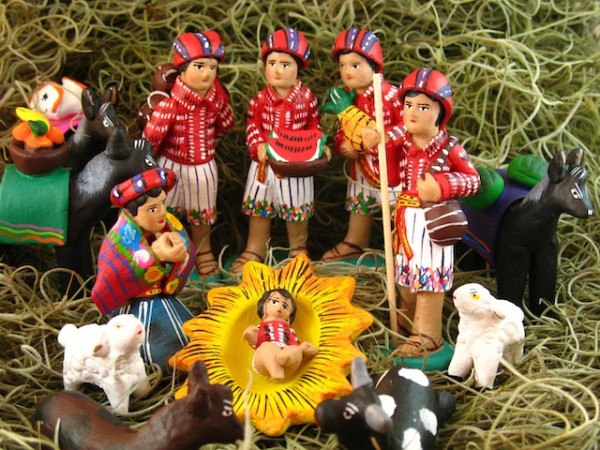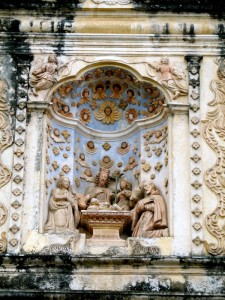Traditions: Posadas and Nacimientos
On the 15th of December the images of Mary and Joseph take to the streets, carried on platforms in small processions called posadas. The faithful follow with torches and candles, singing as they go to the rhythmic beating on turtle shells and high pitches played on clay pipes, both very important to the tradition. The images leave their places in the nacimientos of churches, homes and business establishments to enact the journey of the young couple from Nazareth to Bethlehem to register their citizenship, along with the rest of the population, in the town of their birth. But the young woman is soon to deliver a child, and it’s tough finding lodging for the rest she urgently needs.
There is a ritual of song, as they knock on doors pleading for hospitality, first a verse from the crowd outside, then an answer from those inside the door who tell them to go away. In singsong cruelty, the couple is told, “This is not an inn; move on and don’t bother us. Don’t be a rascal.” Another plea comes from outside, “Don’t be unkind; have a heart. God will reward you.” Again the refusal, “Don’t make me angry. Go.”
At last they come to the place that will shelter the couple for the night, prearranged for the posada, of course. Joseph pleads, “I am a carpenter from Nazareth. My name is Joseph, and my wife is Mary. She will be the mother of the Divine.”
Well, now we’re getting someplace. From the inside, “You are Joseph?! You are Mary?! Come in pilgrims! Come in, not only to our poor house but to our hearts!” It is in fact a great honor for a household to keep the images until the following evening, when they process from that place in the same way as the night before to the next place of lodging. And so it goes every night until December 24, when the images return to their place of origin and where the baby Jesus is placed with them.
Posadas are heard on the streets of cities, towns and villages any night as Christmas approaches and are adaptable to the situation. A fine hotel arranged its own posada, moving the images from place to place within its facilities, and invited guests to participate. One night in 2004 the posada from San Francisco Church in La Antigua fittingly stopped at Casa de Fe, a hospitality house of Obras Sociales del Hermano Pedro.
Oh yes, important to the nightly posadas are the refreshments offered at each home where the couple finds shelter. The air is filled with the aroma of Christmas punch, pineapple, coconut, raisins and other dried fruits, remnant of the Moorish culture brought with the Spaniards.
Cultural interchange characterizes Christmas around the world, and Guatemala contributes more than its share with the abundance of colors and fragrances of natural materials to make the season bright.

